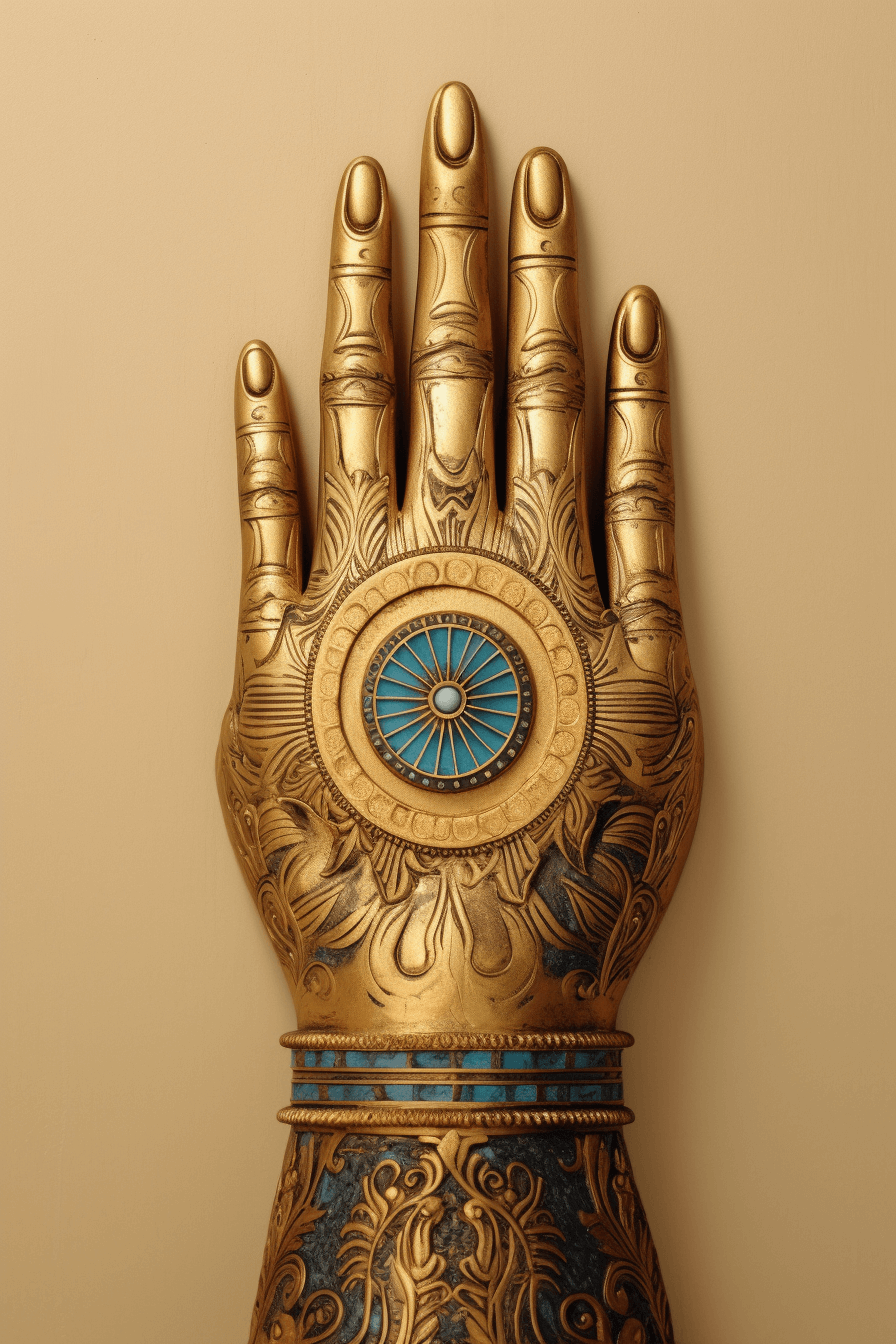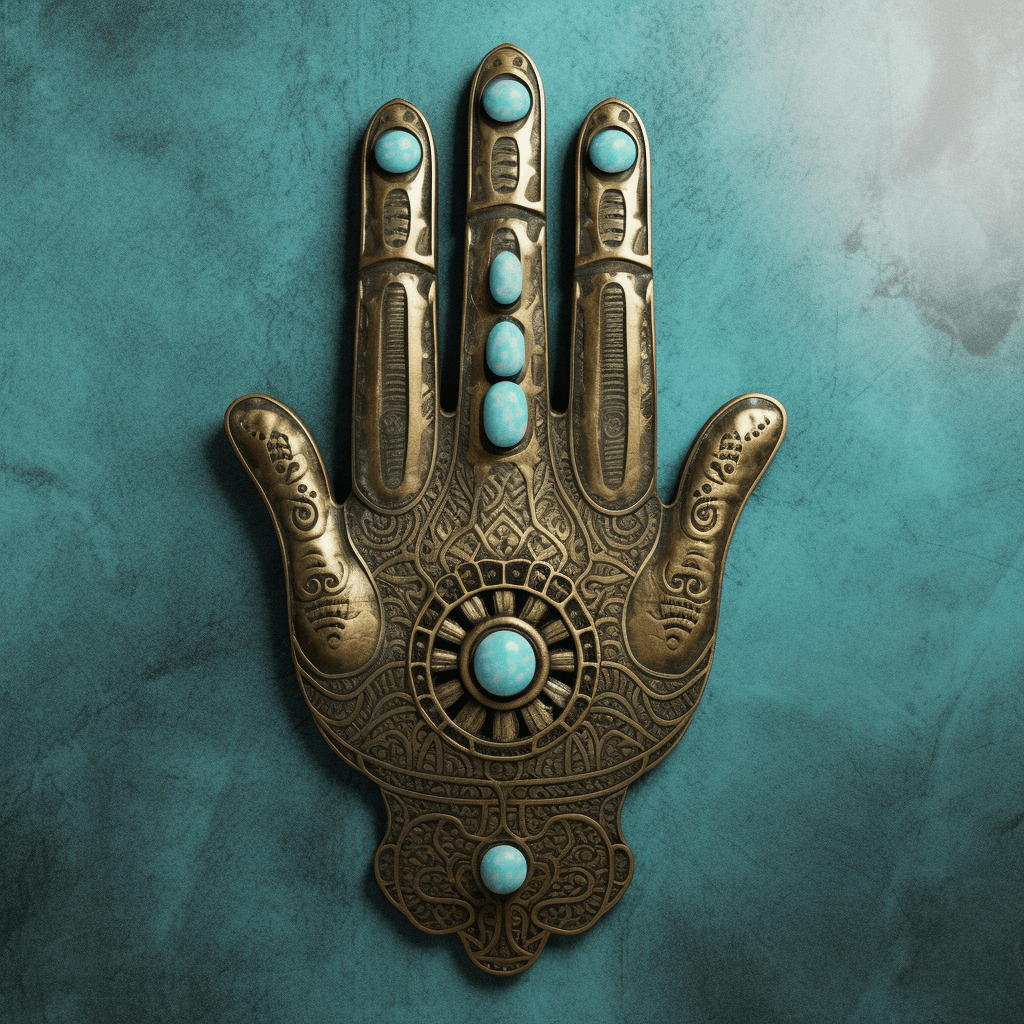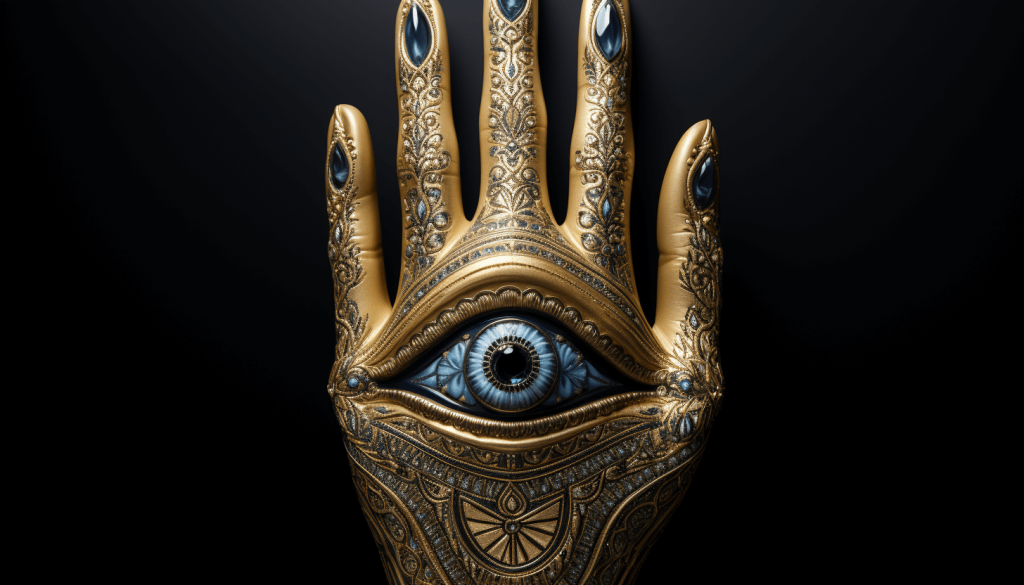The Multifaceted Symbolism of the Hamsa
The Hamsa, also known as the Hand of Fatima, Hand of Miriam, Hand of Mary, and even the Evil Eye Hand, is an ancient symbol that has been revered across numerous cultures and religions. Its distinct shape – an open hand – is universally recognized, with each name revealing a different facet of its rich symbolic tapestry.
Derived from the Arabic word for five, “Hamsa” subtly alludes to the five fingers of the hand. The “Hand of Fatima” pays tribute to Fatima Zahra, the respected daughter of the Prophet Muhammad in Islam. The “Hand of Miriam” and the “Hand of Mary” similarly honor important female figures in Judaism and Christianity respectively. The term “Evil Eye Hand” stems from its function as a talisman against the Evil Eye – a malicious stare believed to cause illness, death, or just general unluckiness.
“The Hamsa is a beacon of protection, warding off negative forces and energy. Regardless of its name – Hand of Fatima, Hand of Miriam, Hand of Mary, or Evil Eye Hand – it remains a powerful symbol of peace, strength, and safety transcending religious and cultural boundaries.”
Hamsa: The Origin and Historical Significance
The origin of the Hamsa symbol is steeped in antiquity. While its exact beginnings remain obscure, the Hamsa is believed to have predated many major religions and appeared in various forms throughout the Middle East and North Africa.
One of the earliest known associations is with the Phoenicians, who used the hand symbol to honor Tanit, the goddess of fertility. The ancient Egyptians also depicted a similar symbol known as the ‘Two Fingers’, representing Osiris and Isis, and used it as a protective amulet.
With the rise of monotheistic religions like Judaism, Christianity, and Islam, the Hamsa symbol was adopted and reinterpreted, resulting in multiple layers of meaning and symbolism attached to this simple, open-hand symbol.
Deciphering the Symbolism of the Hamsa

The Hamsa holds a wealth of symbolism, with each element of its design contributing to its profound meaning. At its core, the Hamsa is seen as a protective symbol, warding off the evil eye and inviting positivity, luck, and health.
- Five Fingers: The five fingers of the Hamsa can represent the five books of the Torah in Judaism, the Five Pillars of Islam in the Islamic faith, or the five senses in the context of the human body.
- The Open Hand: The open hand symbolizes openness and invites blessings, power, and strength. It is a universal sign of protection against any harm or danger.
- The Eye: The eye often depicted in the center of the hand is believed to reflect the evil eye back to the onlooker, protecting the wearer from any negative energy.
The Hamsa is a powerful symbol that not only guards against evil but also fosters blessings and positive energy, making it a treasured symbol across cultures and religions.
The Hamsa in Islam: The Hand of Fatima
In Islam, the Hamsa is often referred to as the “Hand of Fatima“, named after Fatima Zahra, the daughter of the Prophet Muhammad. Fatima is revered for her purity, kindness, and wisdom, and the hand symbolizes her protective nature. The five fingers represent the Five Pillars of Islam: Shahada (faith), Salat (prayer), Zakat (charity), Sawm (fasting), and Hajj (pilgrimage).
The Hamsa is used as a protective amulet against the evil eye in many Muslim cultures, with the open hand and eye symbol believed to deflect any harm. Despite its pre-Islamic origins, the Hamsa has been embraced in Islamic culture and often features intricate Arabic calligraphy or verses from the Quran.
The Hamsa in Judaism: The Hand of Miriam
In Jewish tradition, the Hamsa is known as the “Hand of Miriam“, after Miriam, the sister of Moses and Aaron. Miriam is a symbol of good luck and protection in Judaism, and her hand is believed to shield from negative forces and bring blessings, power, and strength.
The five fingers of the Hamsa can be interpreted as a reference to the five books of the Torah: Genesis, Exodus, Leviticus, Numbers, and Deuteronomy. Jewish Hamsas often feature Hebrew inscriptions of blessings, prayers, or the Shema, the central prayer of Judaism.
Just as in Islam, the symbol of the Hamsa predates Judaism but has been adopted and incorporated into religious and cultural practices, serving as a universal symbol of protection and good fortune.
The Hamsa in Christianity: The Hand of Mary
While the Hamsa is less commonly associated with Christianity, some Christians do refer to it as the “Hand of Mary“, after the mother of Jesus Christ. In Christian contexts, the five fingers of the Hamsa are often seen to symbolize the Five Wounds of Christ suffered during the crucifixion. Others interpret them as representing virtues like faith, hope, love, grace, and peace.
Even though Christian iconography doesn’t typically include the Hamsa, it’s not uncommon to find it in Christian households in the Middle East and North Africa as a symbol of protection against the evil eye.
The Interfaith Appeal of the Hamsa Symbol
One of the most remarkable aspects of the Hamsa symbol is its widespread adoption across multiple faiths and cultures. From Islam and Judaism to Christianity and beyond, this universal symbol transcends religious divides, embodying a shared human desire for protection, blessings, and well-being.
Its powerful symbolism and intricate designs have made the Hamsa a popular motif in art, architecture, and jewelry across the globe. Regardless of the specific cultural or religious context, the Hamsa is almost always associated with warding off the evil eye and attracting positive energy, making it a truly interfaith and cross-cultural symbol.
The Hamsa in Art and Architecture

The Hamsa’s intricate design and symbolic depth have made it a favorite motif in art and architecture. From ancient times to the present, it has been depicted in wall paintings, carvings, mosaics, and frescoes, often at the entrances of homes, shops, and public buildings as a form of protection and blessing.
Its distinctive shape and design make the Hamsa a versatile artistic symbol, and it is often embellished with other motifs such as birds, flowers, and geometric patterns. Contemporary artists also incorporate the Hamsa into their work, reflecting its enduring appeal and cultural relevance.
Hamsa as a Protective Amulet: Warding Off the Evil Eye
One of the most universally recognized uses of the Hamsa is as a protective amulet against the evil eye. The evil eye is a malevolent glare believed to cause misfortune or injury, and is a superstition found in many cultures worldwide.
The Hamsa, with its open palm and often with an eye depicted in the center, is believed to deflect the harmful energy of the evil eye, thus safeguarding the wearer from harm. Whether worn as jewelry, hung on the wall of a home, or incorporated into carvings, the Hamsa stands as a powerful talisman against negative energies and harmful influences.
How to Use Hamsa in Your Daily Life
The Hamsa’s universal appeal and protective nature make it a great addition to daily life. It can be integrated in various ways, each carrying its unique significance and charm. Here are a few ideas:
- Home Decor: Hanging a Hamsa amulet on your front door or living room can bring a sense of protection and ward off negative energy. It’s also a fascinating conversation starter due to its rich symbolism.
- Jewelry: Wearing Hamsa jewelry, such as necklaces, bracelets, or earrings, can serve as a personal protective amulet. It can also help express your faith or cultural identity.
- Stationery: Hamsa motifs on notebooks, cards, or bookmarks can add a touch of mystique and spirituality to your everyday items.
- Artwork: Incorporating the Hamsa symbol in your artwork or craft can be a meaningful and creative way to engage with its symbolism.
Hamsa Jewelry: Expressing Faith and Bringing Protection
As jewelry, the Hamsa is an attractive symbol that merges spirituality, protection, and style. Available in a range of designs, from traditional to contemporary, Hamsa jewelry can be a meaningful gift for yourself or a loved one.
Hamsa necklaces and pendants are particularly popular. They are often designed with the hand facing down, believed to bring good fortune and abundance to the wearer. Hamsa bracelets and earrings are also widely worn for their protective qualities and aesthetic appeal.
Materials vary from silver and gold to gemstone-encrusted pieces, each carrying a unique charm and energy. When choosing Hamsa jewelry, consider the symbolism, personal style, and the intention behind the gesture.
How to Choose the Right Hamsa Amulet
Choosing the right Hamsa amulet largely depends on your personal preference, intention, and the symbolism you connect with. Here are some factors to consider:
- Material: Hamsa amulets can be crafted from various materials like metal, wood, ceramic, or even precious metals like gold and silver. Each material carries its own energy and aesthetic appeal.
- Design: Some Hamsa amulets feature intricate designs and patterns, while others might be plain and simple. The choice between an elaborate or minimalist design is entirely personal.
- Size: Hamsa amulets come in various sizes. If you plan to wear it as jewelry or carry it around, a smaller size might be more practical. However, for home decor, a larger piece can be more visually striking.
- Additional Elements: Many Hamsa amulets include additional symbols like the Evil Eye or inscriptions, each adding to the amulet’s meaning and purpose.
The Hamsa in Modern Pop Culture
The Hamsa, with its timeless allure, has found its way into modern pop culture. Its symbolic and aesthetic appeal transcends cultural boundaries, making it a popular motif in fashion, art, and media.
In the world of fashion, Hamsa has been embraced by famous designers and has graced the runways in various forms, from intricate prints in clothing lines to distinctive jewelry pieces.
The Hamsa symbol is also prevalent in the tattoo world. Many choose it for its rich symbolism and intricate design, expressing their faith, cultural identity, or personal beliefs.
Moreover, the Hamsa frequently appears in films, TV series, and books, often used to represent protection, spirituality, or a connection to Middle Eastern culture. Its presence in modern pop culture attests to the enduring relevance and versatility of this ancient symbol.
Controversies and Misunderstandings Around the Hamsa Symbol
Despite its wide-ranging appeal, the Hamsa has not been immune to controversy and misunderstanding. Its multi-cultural origins and diverse interpretations have sometimes led to disputes about its ‘true’ meaning and rightful ownership.
- Religious Ownership: Because the Hamsa is significant in Judaism, Islam, and Christianity, debates often arise about which religion it truly belongs to. It is crucial to remember that the Hamsa symbol transcends religious boundaries, and its interpretation can vary depending on personal and cultural beliefs.
- Commercialization and Appropriation: The Hamsa’s popularity in fashion and pop culture has led to accusations of cultural appropriation, particularly when it’s used without understanding its cultural and historical significance. This emphasizes the importance of respecting and acknowledging the symbol’s roots while using it.
- Misinterpretations: The myriad interpretations of the Hamsa can sometimes lead to misunderstandings and incorrect usage. It’s essential to be informed about the symbol’s various meanings and contexts to appreciate its full significance.
The Hamsa as a Symbol of Peace and Coexistence
The Hamsa, despite its diverse cultural origins and meanings, primarily symbolizes protection, blessing, and strength. Its unique characteristic lies in its universal appeal, transcending religious, cultural, and geographical boundaries. It serves as a powerful symbol of peace, coexistence, and shared human values.
Whether you choose to wear it as jewelry, display it in your home, or simply appreciate its symbolic value, the Hamsa invites you to embrace a world-view that values unity in diversity and cherishes a shared sense of humanity.
Frequently Asked Questions
Is it okay to wear the hamsa hand?
Yes, it’s okay to wear the Hamsa hand. It’s widely used in jewelry and is believed to provide protection and good fortune. However, it’s important to respect its cultural and religious significance.
Is Hamsa a Buddhist?
No, the Hamsa is not a Buddhist symbol. It’s primarily associated with Middle Eastern religions such as Judaism, Islam, and to some extent, Christianity.
What does Hamsa mean in the Quran?
While the Hamsa is not directly mentioned in the Quran, it’s often associated with Fatima, the daughter of the Prophet Muhammad, in Islamic culture. The five fingers of the Hamsa are believed to represent the Five Pillars of Islam.
Which is better, evil eye or Hamsa?
Both the Hamsa and the Evil Eye are considered protective symbols, and their effectiveness depends on personal and cultural beliefs. Some people wear them together for added protection.
What religions use Hamsa?
The Hamsa is used in Judaism, Islam, and Christianity, and is also embraced by some secular and New Age cultures.
Is the Hamsa hand Moroccan?
The Hamsa is widely used in Morocco and other North African cultures, but it also has roots in the Middle East and is used globally.
Is the Hamsa hand Egyptian?
Yes, the Hamsa has origins in ancient Egypt where it was a symbol of protection and good fortune. However, it has since been adopted by many other cultures and religions.
Is there a Hamsa emoji?
As of my knowledge cutoff in 2021, there’s no dedicated Hamsa emoji in the standard set. However, this may change in future updates.
Where should I hang my Hamsa?
A Hamsa can be hung in a place where you want to ward off negative energy. Common placements include entrances to homes or rooms, in cars, or in workplaces.
Can you wear the evil eye and the Hamsa together?
Yes, it’s common to see the Hamsa and Evil Eye worn together, especially in jewelry, as they’re both symbols of protection.
Why is the evil eye in the Hamsa?
The Evil Eye is often incorporated into Hamsa designs to combine the protective powers of both symbols. The Hamsa is believed to ward off harm, while the Evil Eye protects against jealousy and ill-wishing.

